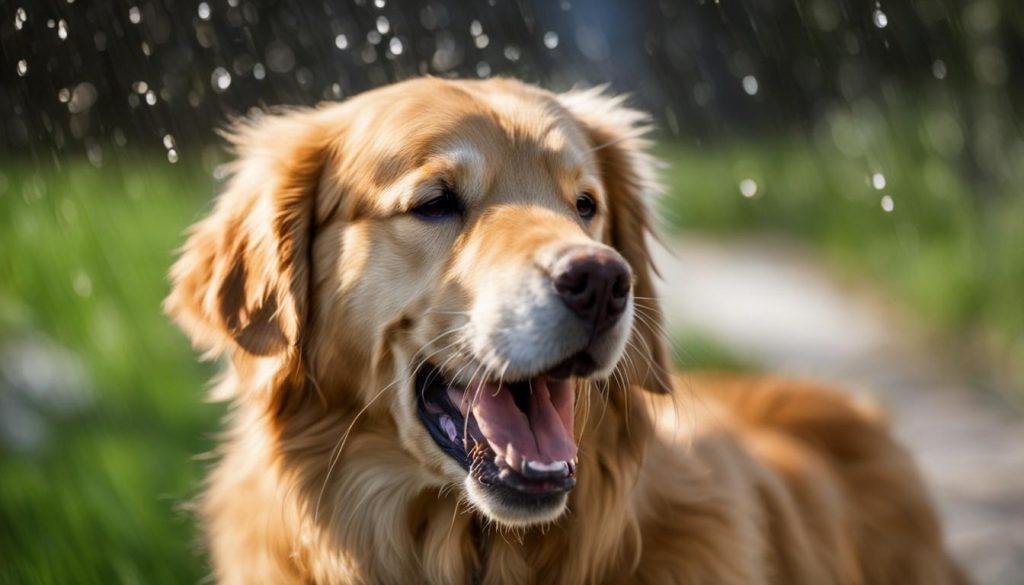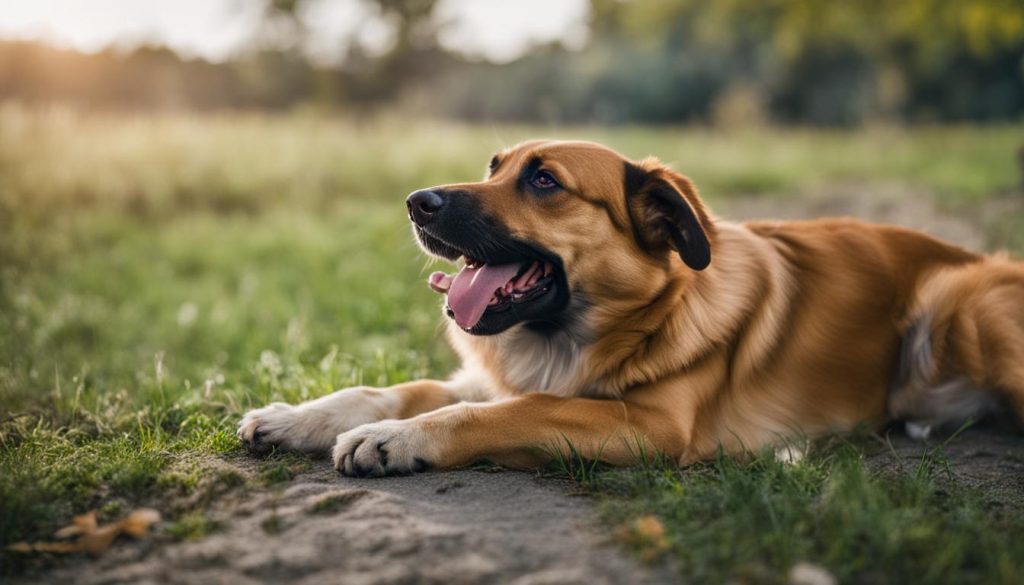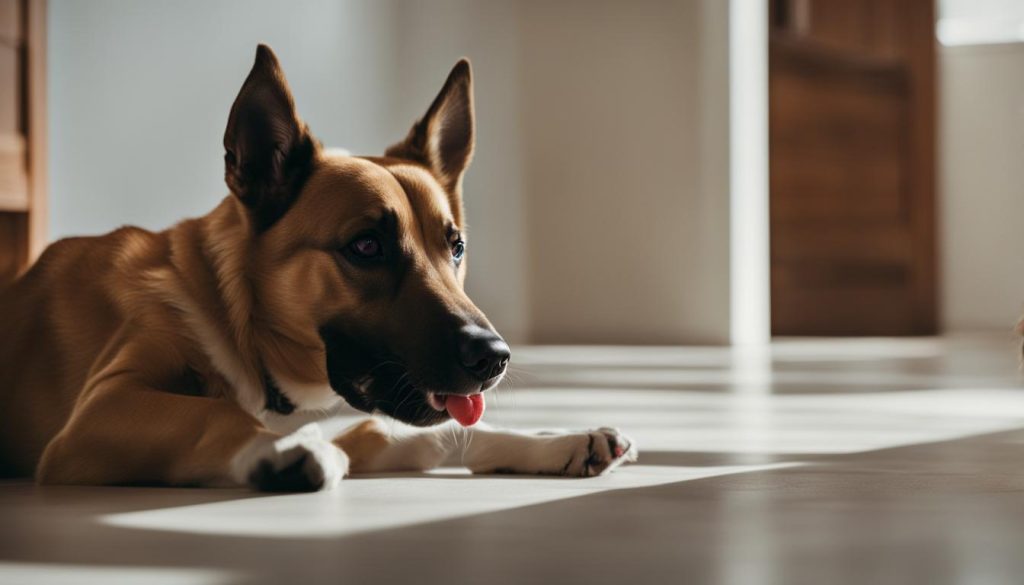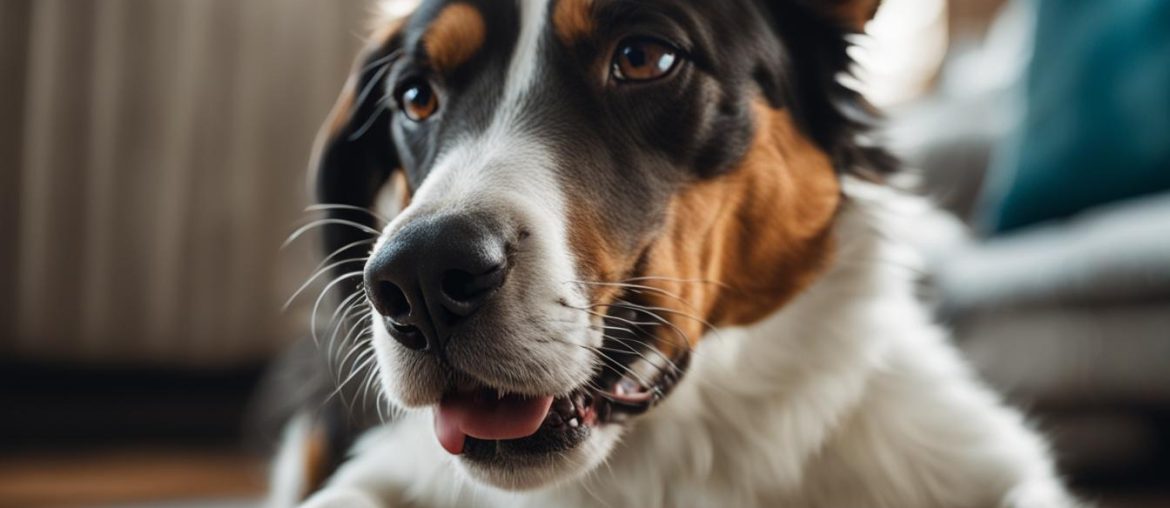Excessive dog licking can be a common behavior that may indicate various underlying causes. While some dogs lick as a sign of affection or to groom themselves, excessive licking can lead to skin irritation and interfere with their daily activities. It is important to understand the reasons behind excessive licking and implement strategies to manage or redirect this behavior.
Key Takeaways:
- Excessive dog licking can indicate anxiety, discomfort, or pain.
- Understanding the reasons behind dog licking can help address the behavior effectively.
- Excessive licking can be a symptom of underlying health issues or behavioral problems.
- Implementing training techniques and natural remedies can help combat excessive licking.
- Professional advice may be necessary in some cases to manage excessive licking in dogs.
Why Do Dogs Lick?
Dogs have a natural inclination to lick, and this behavior serves various purposes. Understanding why dogs lick can provide valuable insight into their behavior and help address any excessive licking tendencies. Here are some key reasons why dogs lick:
- Bonding: Licking is a way for dogs to bond with their human companions and other dogs. It is a sign of affection and a means of strengthening social connections.
- Grooming: Dogs lick themselves and others as part of their grooming routine. It helps keep their coats clean and free from dirt, debris, and parasites.
- Communication: Licking is a form of communication for dogs. It can convey various messages, such as seeking attention, expressing submission, or showing empathy towards their pack members.
By licking, dogs can also explore their surroundings and gather information about their environment. It allows them to assess the scents, tastes, and moods of other animals and people.

Table: Common Reasons for Dog Licking
| Reason | Description |
|---|---|
| Bonding | Dogs lick to establish and strengthen social bonds with humans and other dogs. |
| Grooming | Licking helps dogs keep themselves clean and remove dirt, debris, and parasites from their fur. |
| Communication | Licking is a way for dogs to communicate various messages, such as seeking attention or showing submission. |
| Exploration | By licking, dogs gather information about their environment, including scents, tastes, and moods. |
Please be aware that while licking is a normal behavior, excessive licking can indicate underlying issues such as anxiety, discomfort, or health problems. If your dog’s licking becomes excessive or problematic, it’s advisable to consult with a veterinarian or a professional dog behaviorist to determine the cause and appropriate management techniques.
When Does Licking Become a Problem?
While licking is a natural behavior for dogs, it can become a problem when it becomes excessive or disrupts daily life. Excessive licking, also known as “lick granuloma” or “acral lick dermatitis,” can be a sign of underlying health issues, anxiety, or obsessive-compulsive disorder (OCD) in dogs. Recognizing the signs of excessive licking is crucial in addressing the problem and providing appropriate care for our furry friends.
There are several signs that indicate excessive dog licking. These signs include persistent licking that causes raw or irritated skin, hair loss in specific areas, redness or inflammation, and behavioral changes such as restlessness or irritability. It’s important to observe your dog’s licking behavior and consider seeking professional advice if you notice any of these signs.
Excessive licking can have various causes. It can be a result of allergies, infections, or pain, causing dogs to excessively lick themselves or others. Anxiety and stress can also contribute to excessive licking behaviors. In some cases, dogs may develop obsessive-compulsive disorder, leading to compulsive licking even when no underlying medical condition is present. Identifying the root cause of the excessive licking is essential in determining the appropriate course of action.
Table: Signs and Causes of Excessive Dog Licking
| Signs of Excessive Dog Licking | Causes |
|---|---|
| Persistent licking causing raw or irritated skin | Allergies, infections, pain |
| Hair loss in specific areas | Allergies, stress, OCD |
| Redness or inflammation | Allergies, infections |
| Restlessness or irritability | Stress, anxiety |
Understanding the signs and causes of excessive dog licking can help us address the problem effectively. In the next section, we will explore various tips and techniques to manage and reduce excessive licking behaviors in dogs.
Addressing Excessive Licking: Tips and Techniques
Excessive licking in dogs can be a challenging behavior to manage, but with the right strategies, it can be addressed effectively. Here are some tips and techniques to help discourage and redirect excessive licking in your dog:
1. Provide Mental and Physical Stimulation
Dogs may engage in excessive licking when they’re bored or lacking mental and physical stimulation. Make sure your dog has plenty of toys, puzzles, and interactive games to keep their mind engaged. Regular exercise and playtime can also help release excess energy and reduce the likelihood of excessive licking behaviors.
2. Redirect the Licking Behavior
When you notice your dog engaging in excessive licking, redirect their attention to an alternative behavior. Offer them a chew toy, puzzle toy, or a treat-dispensing toy to keep them occupied. By giving your dog an appropriate outlet for their oral fixation, you can redirect their licking behavior and help them develop healthier habits.
3. Use Positive Reinforcement
Positive reinforcement techniques can be incredibly effective in discouraging excessive licking. Whenever your dog refrains from licking or engages in an alternative behavior, such as sitting or lying down, reward them with praise, treats, or a favorite toy. This will reinforce the desired behavior and motivate your dog to engage in it more frequently.
4. Address Underlying Health Issues
If your dog’s excessive licking is persistent and accompanied by other symptoms, it’s essential to consult with a veterinarian. Underlying health issues, such as allergies or infections, can cause discomfort and lead to excessive licking. Treating the underlying issue will not only alleviate your dog’s discomfort but also help reduce their licking behavior.
By implementing these tips and techniques, you can effectively manage and reduce excessive licking in your dog. Remember, consistency and patience are key when addressing any behavioral issue. If the problem persists or worsens, it’s always best to seek professional advice from a veterinarian or a certified dog trainer.

Table: Common Techniques to Manage Excessive Dog Licking
| Technique | Description |
|---|---|
| Provide mental and physical stimulation | Engage your dog in activities that keep their mind and body active, reducing boredom and the urge to lick excessively. |
| Redirect the licking behavior | Offer your dog an alternative, appropriate behavior to focus on when they start excessive licking, such as providing a chew toy or treat-dispensing toy. |
| Use positive reinforcement | Reward your dog with praise, treats, or toys when they refrain from licking or engage in alternative behaviors. |
| Address underlying health issues | If excessive licking persists and is accompanied by other symptoms, consult with a veterinarian to identify and treat any underlying health issues. |
Letting Your Dog Lick Your Face: Considerations
Allowing your dog to lick your face is a personal choice that many dog owners make. It can be a way to bond with your furry friend and show affection. However, it’s important to be aware of the potential risks and take precautions to ensure both your and your dog’s health.
Health Risks of Dog Saliva: Dog saliva contains bacteria and parasites that can be harmful to humans. While most dogs have harmless bacteria in their mouths, there is still a small risk of transmitting illnesses. Some of the bacteria commonly found in dog saliva include:
- Capnocytophaga canimorsus: This bacteria can cause serious infections, especially in individuals with weakened immune systems.
- Salmonella: Dogs can carry this bacteria, which can cause gastrointestinal illness in humans.
- Campylobacter: Another bacteria found in dog saliva that can cause gastrointestinal issues in humans.
Personal Choice and Precautions: The decision of whether to let your dog lick your face ultimately depends on your comfort level and understanding of the potential risks involved. If you choose to allow it, there are some precautions you can take to minimize the health risks:
- Wash your face thoroughly after being licked by your dog to remove any bacteria or potential allergens.
- Keep up with your dog’s oral hygiene by regularly brushing their teeth and gums.
- Ensure your dog is up to date on vaccinations and regularly checked by a veterinarian to minimize the risk of infectious diseases.
- Teach your dog proper licking boundaries to prevent them from licking excessively or in sensitive areas.
Remember, the decision of whether or not to let your dog lick your face is a personal one. By understanding the potential risks and taking necessary precautions, you can make an informed decision that suits both you and your dog’s well-being.
| Health Risks | Precautions |
|---|---|
|
|
Understanding Your Dog’s Licking Behavior: Common Scenarios
Dogs have different licking behaviors in various scenarios. Understanding these behaviors can help provide insight into your dog’s needs and emotions. Here are some common scenarios where dogs may engage in licking:
Morning Licking:
Dog licking in the morning is often a way for them to greet you and show affection. It’s their way of saying good morning and expressing their love. This behavior can also stem from their instinctual desire to groom themselves and their pack members. Morning licking is generally a positive behavior and a sign of affection.
Licking Owners:
Some dogs may lick their owners more than others. This can be attributed to a variety of factors, including the dog’s attachment to their owner and their overall personality. Dogs may lick their owners as a way to seek attention, show affection, or even alleviate their own anxiety. It’s important to establish boundaries and provide alternative ways for your dog to express their love and seek attention.
Licking When Being Stroked:
Dogs may lick themselves or their owner’s hand when being stroked. This behavior can be a sign of enjoyment and relaxation. Licking when being stroked is often a way for dogs to express contentment and show their appreciation for the physical touch. It’s important to remember that not all dogs enjoy being touched in the same way, so it’s essential to observe your dog’s body language and adjust your interactions accordingly.
Licking After Eating:
After a meal, dogs may engage in licking as a way to clean their faces and remove any food residue. This behavior is similar to cats grooming themselves after eating. Licking after eating can also be a sign of satisfaction and contentment. If your dog excessively licks after eating, it’s important to ensure that they are not experiencing any digestive discomfort or underlying health issues.
Understanding your dog’s licking behavior in different scenarios can help you better interpret their needs and emotions. Observing their body language and providing appropriate outlets for their natural instincts can contribute to a happier and healthier canine companion.

Table: Common Dog Licking Behaviors
| Scenario | Behavior |
|---|---|
| Morning | Licking as a greeting and show of affection |
| Licking Owners | Seeking attention, showing affection |
| Licking When Being Stroked | Expressing contentment and enjoyment |
| Licking After Eating | Cleaning the face, sign of satisfaction |
Health Issues and Excessive Licking
Excessive licking in dogs can often be attributed to underlying health issues. Understanding these health issues is crucial in effectively managing and addressing the behavior. Here are some common health issues that can cause excessive licking in dogs:
- Allergies: Dogs can develop allergies to certain substances, such as pollen, dust mites, or certain foods. These allergies can cause itchiness and discomfort, leading to excessive licking as a way to alleviate the irritation.
- Infections: Infections, such as yeast or bacterial infections, can lead to intense itching and discomfort in dogs. To relieve these symptoms, dogs may excessively lick themselves, focusing on the affected areas.
- Pain: Dogs in pain may resort to excessive licking as a way to self-soothe or alleviate discomfort. Whether it’s due to arthritis, injury, or an underlying medical condition, pain can trigger excessive licking behaviors in dogs.
Addressing Health Issues
When dealing with excessive licking caused by health issues, it is important to seek veterinary advice. A thorough examination of your dog’s skin, a possible allergy test, or the use of medications to treat underlying infections or pain may be necessary. Identifying and addressing the root cause of the excessive licking will help alleviate the discomfort and reduce the behavior.
It is worth noting that the information provided here is not exhaustive, and it is best to consult with a veterinarian for a comprehensive evaluation and tailored treatment plan for your dog.

| Health Issue | Cause | Behavioral Manifestations |
|---|---|---|
| Allergies | Reactions to allergens such as pollen, dust mites, or certain foods | Intense itching, redness, skin rashes, excessive licking |
| Infections | Yeast or bacterial infections | Intense itching, odor, discharge, lesions, excessive licking |
| Pain | Arthritis, injury, underlying medical conditions | Limping, reluctance to move, sensitivity to touch, excessive licking |
Behavioral Issues and Excessive Licking
Excessive licking in dogs can often be attributed to behavioral issues. Boredom is one such cause, as dogs may resort to excessive licking as a way to occupy themselves. Providing mental enrichment through interactive toys, puzzle feeders, and regular exercise can help alleviate boredom and reduce licking behavior.
Anxiety is another common cause of excessive licking in dogs. Just like humans, dogs can experience anxiety and may resort to licking as a coping mechanism. It’s important to address the underlying anxiety by creating a calm and secure environment for your dog. This can be achieved through the use of pheromone diffusers, desensitization techniques, and positive reinforcement training.
Implementing strategies to manage behavioral causes of excessive licking is crucial. Redirecting your dog’s focus to more appropriate behaviors, such as interactive play or training sessions, can help deter excessive licking. Additionally, providing plenty of mental and physical stimulation, along with regular routines and consistent training, can help reduce anxiety and boredom, ultimately decreasing the likelihood of excessive licking.

Boredom and Excessive Licking
“Dogs that are bored may develop repetitive behaviors, such as excessive licking. It’s essential to provide them with mental stimulation and opportunities to engage in interactive play to prevent boredom-related licking.”
Anxiety and Excessive Licking
“Anxiety can manifest in various ways, including excessive licking. Identifying and addressing the underlying anxiety triggers can help reduce the occurrence of excessive licking behaviors in dogs.”
Strategies to Manage Behavioral Causes of Licking
- Create a stimulating environment with plenty of toys and interactive activities.
- Establish a consistent routine to provide structure and reduce anxiety.
- Use positive reinforcement training to redirect your dog’s focus to more appropriate behaviors.
- Consider the use of calming aids, such as pheromone diffusers or anxiety wraps.
- Engage in regular exercise to help alleviate boredom and reduce excess energy.
| Behavioral Causes of Excessive Licking | Strategies to Manage |
|---|---|
| Boredom | Provide mental stimulation through interactive toys and regular exercise. |
| Anxiety | Create a calm environment, use desensitization techniques, and consider pheromone diffusers. |
Wrapping Up
Excessive licking in dogs can be a common behavior with various underlying causes. Understanding the reasons behind excessive licking and implementing appropriate strategies can help manage or redirect this behavior. It is important to consider both physical and behavioral factors when addressing excessive licking, and seeking professional advice may be necessary in some cases.
When dealing with excessive licking in dogs, it is crucial to identify the root cause. Whether it is due to health issues, such as infections or allergies, or behavioral factors, like boredom or anxiety, a targeted approach can be effective in curbing this behavior. By addressing the underlying cause, we can help our furry friends find relief and improve their overall well-being.
Some strategies to consider include providing mental enrichment, engaging in regular exercise, and ensuring a healthy and balanced lifestyle for your dog. These measures can help alleviate boredom, reduce anxiety, and create a more fulfilling environment for your pet. Remember, patience and consistency are key when implementing these strategies.
To summarize, by understanding the causes and implementing the appropriate strategies, we can effectively manage excessive licking in dogs. It is essential to prioritize the health and happiness of our beloved pets, ensuring that they lead fulfilling lives free from discomfort caused by excessive licking behavior.
FAQ
How can I stop my dog from excessive licking?
To stop your dog from excessive licking, it is important to identify the underlying cause of the behavior. This can include factors such as anxiety, allergies, infections, or pain. Once the cause is determined, you can implement strategies such as addressing health issues, providing mental stimulation, exercise, and seeking professional advice when necessary.
Why do dogs lick?
Dogs lick for various reasons, including grooming themselves and others, as a form of communication, bonding, and to express affection. Licking can also be a way for dogs to explore their environment and assess others’ moods.
When does excessive licking become a problem?
Excessive licking becomes a problem when it causes skin irritation, disrupts daily activities, or indicates underlying health issues such as anxiety, infections, or pain.
How can I address excessive licking in dogs?
To address excessive licking in dogs, you can implement strategies such as identifying and addressing underlying health issues, providing mental enrichment and regular exercise, and managing underlying anxieties. Seeking professional advice may also be necessary in some cases.
Is it safe to allow my dog to lick my face?
Allowing your dog to lick your face is a personal decision. However, it is important to be aware that dog saliva contains bacteria and parasites, and there is a small risk of transmitting illnesses. Taking precautions such as washing your face after being licked can minimize any potential health risks.
What are common scenarios where dogs exhibit specific licking behaviors?
Common scenarios where dogs exhibit specific licking behaviors include licking in the morning, licking their owners more, licking when being stroked, and licking after eating.
Can excessive licking in dogs be caused by health issues?
Yes, excessive licking in dogs can be caused by health issues such as infections (yeast or bacterial), allergies, or pain. Identifying and addressing these underlying health issues is essential in managing excessive licking.
Can behavioral issues contribute to excessive licking in dogs?
Yes, behavioral issues such as boredom, lack of mental stimulation, anxiety, and stress can contribute to excessive licking in dogs. Providing mental enrichment, regular exercise, and addressing underlying anxieties can help manage the behavioral causes of excessive licking.






